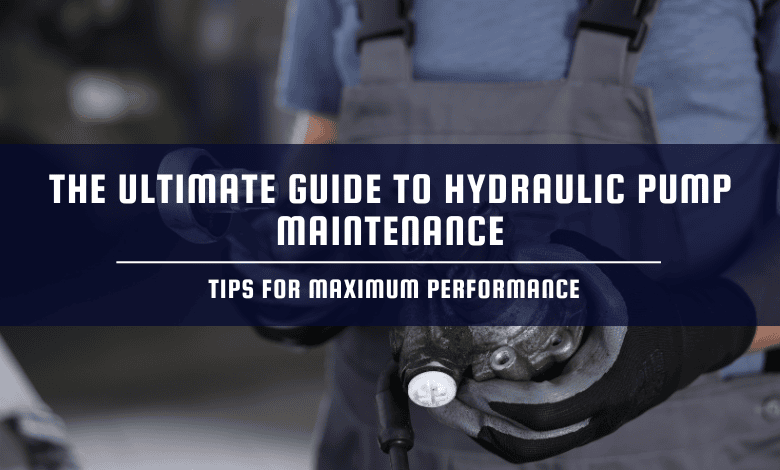The Ultimate Guide to Hydraulic Pump Maintenance: Tips for Maximum Performance

The hydraulic pump is rightly called the heart of any hydraulic system. Whether it drives the massive forces of an excavator, controls the precision of a manufacturing press, or powers the lifting capacity of a forklift, its reliable performance is central to the entire operation. However, like any heart, it requires diligent care to function at its peak. Neglect can lead to reduced efficiency, premature wear, costly breakdowns, and ultimately, system failure. Mastering hydraulic pump maintenance is not just a matter of fixing problems; it is a strategic approach to maximizing efficiency, ensuring longevity, and guaranteeing the highest level of performance from your most valuable equipment.
The vast majorities of hydraulic pump maintenance failures is not due to inherent design flaws but are a direct result of contamination and overheating. Addressing these two factors through a proactive maintenance schedule can dramatically extend the life of the pump, often well beyond its expected service life. A comprehensive maintenance strategy moves beyond simple visual checks and dives into the science of fluid analysis and system hygiene.
The Lifeblood of the System: Fluid Quality and Contamination Control
The most critical element in any hydraulic system is the fluid itself. It serves multiple roles: transmitting power, lubricating moving parts, and dissipating heat. Therefore, maintaining the quality and cleanliness of the hydraulic fluid is the single most important maintenance task.
Contamination is the number one killer of hydraulic pumps. Solid particles, such as dirt, metal shavings, and wear debris, act like sandpaper, accelerating the wear of internal components like pistons, gears, and vanes. Water is another major contaminant, leading to corrosion and reducing the fluid’s lubricating properties.
To control contamination, several steps must be routine:
- Regular Fluid Analysis: This should be performed at scheduled intervals, typically every six months or based on operating hours. A lab analysis can detect microscopic particles, water content, and chemical degradation long before any symptoms appear in the system. The lab report provides a crucial warning sign about pump wear or filter failure.
- Filter Management: Filters are the system’s defense. Always use high-quality filters that meet the manufacturer’s specified micron rating. Filters should be checked and replaced according to the manufacturer’s schedule or when a gauge indicates a pressure drop, signifying clogging. Never bypass a clogged filter, as this immediately introduces harmful contaminants into the system.
- Sealing and Venting: Ensure all reservoir breathers and seals are intact. A breather is designed to allow air movement but prevent particle ingress. Using a high-efficiency breather can significantly reduce the intake of atmospheric contaminants.
Temperature Control: Preventing Thermal Breakdown
Heat is the second greatest enemy of a hydraulic pump. Excessive operating temperature can cause the hydraulic fluid to break down prematurely (thermal degradation), leading to sludge formation, varnish deposits, and a loss of lubricating ability. This breakdown creates a vicious cycle: poor lubrication causes more friction, which generates more heat, accelerating the deterioration of both the fluid and the pump components.
Maintaining the correct operating temperature involves:
- Cooler Inspection: Regularly clean and inspect the hydraulic fluid cooler. Dirt, debris, and sludge on the fins or internal passages of the cooler will reduce its efficiency. Ensure that airflow to the cooler is never restricted.
- Fluid Level Monitoring: Ensure the fluid level in the reservoir is maintained correctly. Low fluid levels can cause aeration (air in the fluid), which increases heat generation and can lead to pump cavitation, a destructive process where air bubbles implode inside the pump, eroding metal surfaces.
- Addressing Overheating Causes: If the system is consistently running hot, it’s a symptom of a problem that needs fixing, not just managing. Common causes include running the pump at excessively high pressure, using an incorrect fluid viscosity, or issues with system relief valves.
Conclusion: The Investment in Longevity
Hydraulic pump maintenance is a critical investment in the overall health and productivity of your equipment. It is a scientific discipline rooted in controlling the system’s two main enemies: contamination and heat. By committing to regular fluid analysis, diligent filter replacement, annual cooler inspections, and immediately investigating any unusual noise, you move from a reactive state of expensive emergency repairs to a proactive state of optimized performance and longevity. This comprehensive approach to stewardship not only reduces your operational costs but ensures that the heart of your machine beats reliably and powerfully for years to come.
Check out more insightful articles that will leave you informed and inspired.





